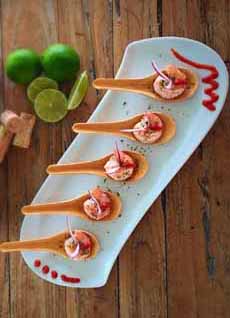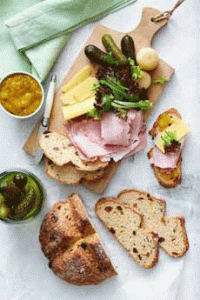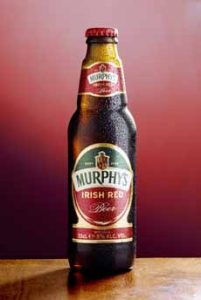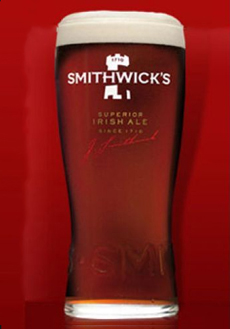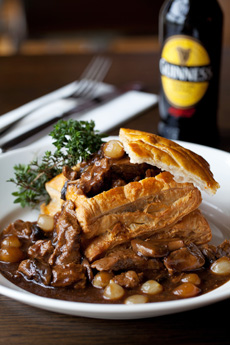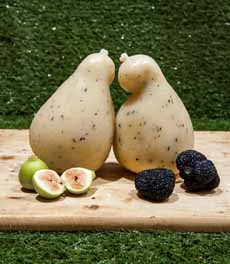|
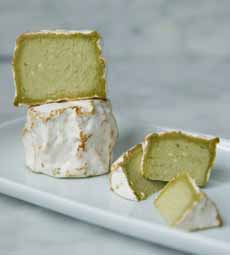
[1] The newest green cheese: Vermatcha, colored with powdered matcha tea (photo courtesy Murray’s Cheese).

[2] Basiron is a Dutch cheese, made in the style of Gouda in eight different flavors! The green variety is mixed with powdered basil

[3] With Sage Derby, a cheddar-like cheese, the curds are pressed with powdered sage to create a lovely marbled effect (photo courtesy Ford Farm).
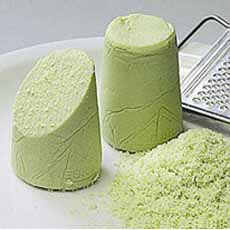
[4] Schabziger, made for some 1300 years, is colored pale green with an herb, blue fenugreek (photo courtesy Geska).
|
|
“The moon is made of green cheese.”
This expression began centuries ago in a fable for children. It’s in a story about a simpleton who sees a reflection of the moon in a pond, and mistakes it for a round wheel of cheese.
The concept evolved to refer to people who are so gullible as to believe that the moon is made of cheese.
In 1546, The Proverbs of John Heywood described convincing someone that “the moon is made of a greene cheese.”
In those days, “green” referred to unaged cheese. An unaged cheese is soft, and hasn’t yet developed a rind.
When we first saw the phrase, in our early childhood, it was in an illustrated book of tales that showed the moon in a shade of pale green, against a dark sky.
We were years away from knowing that “green” also meant young or fresh; but as with other children, we delighted in the idea of a moon made of green cheese.
THE EMERGENCE OF REAL GREEN CHEESE
Today you can purchase cheeses that have green-colored paste (i.e., the part of the cheese that’s under the rind).
In this century, we’ve seen—and tasted—green cheeses, made by adding basil or other herbs to the vat. One cheese little-known in the U.S. dates back 1300 years. Others are more recent. A selection:
Basiron Pesto: Basiron is a Dutch cheese made in the Gouda style (photo #2). It’s available in 22 different flavors including bacon, chocolate and wasabi. The green shade is achieved with basil.
Roquefort Societé Bee: Some roqueforts have green veins instead of blue, due to particular microbes in the cellars where they age.
Sage Derby: Similar to cheddar, Derby is best known in its “green” form (photo #3). Ground sage and spinach juice give this cheese its green color and soft, herbal flavor.
Schabziger: This pale green cheese (photo #4) was first made by Swiss monks in the 8th century. It’s sold in the U.S. under the brand Sap Sago. The color comes from an herb called blue fenugreek.
Tintern, an aged cheddar sporting green flecks of chive in the paste and a bright green wax exterior.
VERMATCHA: JUST IN TIME FOR ST. PATRICK’S DAY
Add another green cheese to the lineup!
Just in time for St. Patrick’s Day, Murray’s Cheese has created Vermatcha, a colorful cheese made by mixing Champlain Valley Organic Triple Cream with matcha green tea powder (photo #1).
The matcha is added and the cheeses are aged in Murray’s bloomy cave for approximately 10 days.
The bloomy-rind beauty that emerges has a vibrant green paste under a thin, snowy rind, which is definitely edible and has earthy hints of mushroom.
The paste (interior) is very creamy, with a luxurious velvet mouthfeel and a complex depth of flavor. It has a slightly herbal flavor from the matcha.
It’s a unique and eye-catching cheese.
GET YOURS BEFORE THE SUPPLY RUNS OUT. Buy it here.
MORE ST. PATRICK’S DAY CHEESE IDEAS
Create An Irish Cheese Board
More Irish Cheeses
Have An Irish Cheese & Beer Party
|
